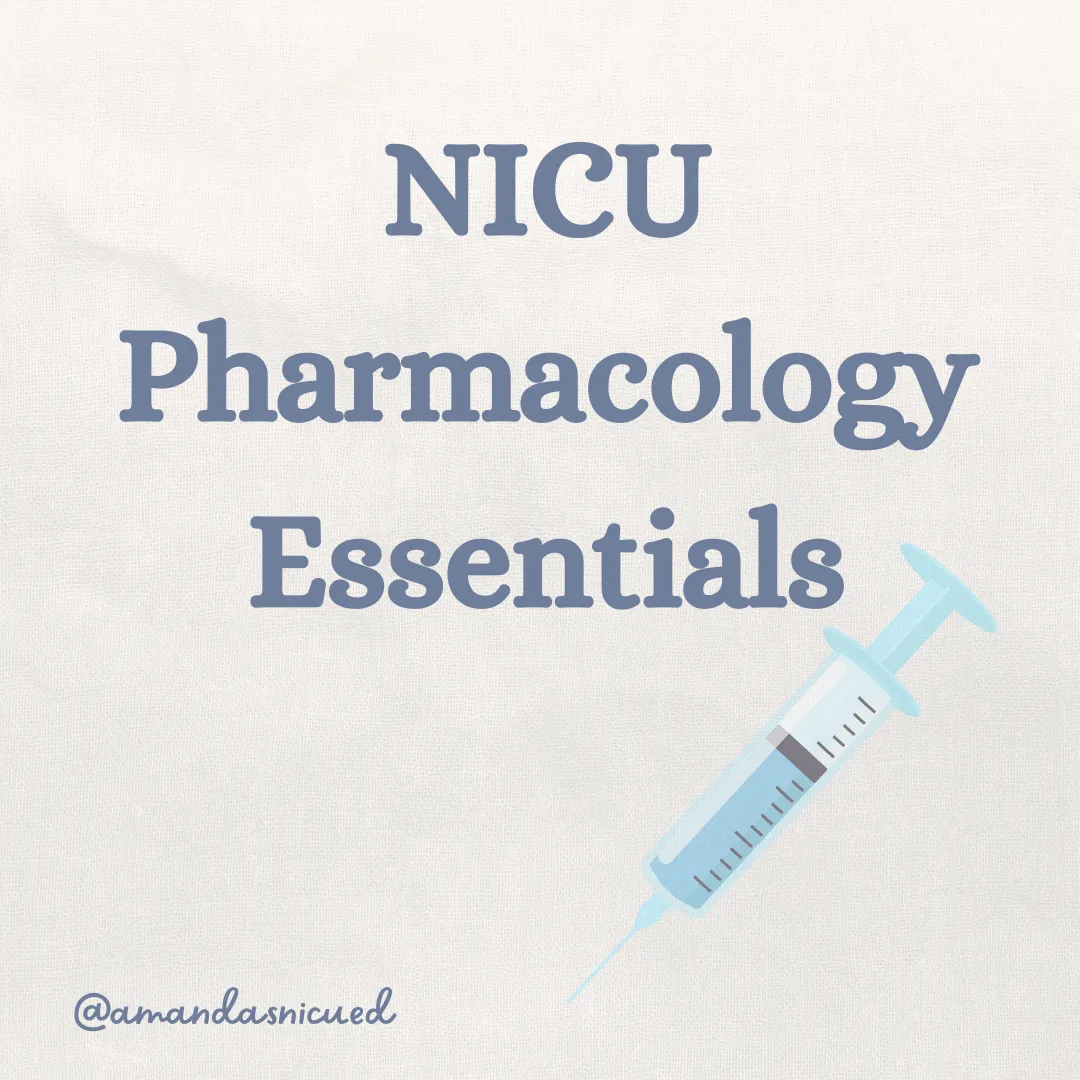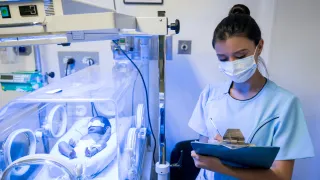
Welcome to Amanda's NICU Education




Hi! My name is Amanda. I'm a NICU nurse, Clinical Nurse Specialist, NICU Educator... basically your NICU BFF. If you want to talk NICU, I'm here for you! I love everything about NICU nursing and I'm eager to learn and share my knowledge with all my NICU friends.
I have been a NICU nurse since 2009 I am currently a Clinical Nurse Specialist in a Level IV NICU in Los Angeles.
I am passionate about educating the next generation of NICU nurses. I share my knowledge through platforms such as Instagram and Facebook and am excited to have you here on my website!
Click on the button below to sign up for my newsletter filled with NICU education and tips for all experience levels.

Not very many people love taking tests but as a self-acclaimed "forever student" who has taken (and passed) five different certification exams I am no longer afraid of tests! "Way to brag", you might be thinking but I want to help YOU pass your certification exam too!
Introducing Amanda's RNC-NIC Success digital course - your ultimate study companion!
Gain unlimited, on-demand access for life, ensuring you're primed to ace your certification exam.
I'm here to help you succeed and I can't wait for you to share with me that you PASSED the RNC-NIC EXAM!!!










Master the principles of pharmacology
Pharmacology Essentials
There is essential principles of pharmacology we must know and understand when caring for our sweet patients.
Let's review absorption, distribution, metabolism, and elimination and how each of those principles differ in neonates compared to other populations.

Absorption is the rate at which a drug enters the blood stream. This will vary based on the route of administration. For example, drugs administered intravenously are directly injected into the blood stream and have 100% bioavailability. Drugs administered via the enteral route can have varying degrees of absorption.
Many medications are given via the enteral route due to its lower infection risk, cost, and ease of administration. Some considerations we must make when administering enteral medications in neonates include the slow gastric emptying time compare to other populations. Prolonged transit time and enterohepatic recirculation can increase the bioavailability of the drug. Bioavailability can also be decreased in instances where there is shortened transit time (diarrhea or emesis), GI destruction of the medication, or first pass metabolism.
The acidity of the GI tract also has an impact on the absorption of a drug. At birth the GI tract is a nearly neutral pH (or slightly alkaline) due to the presence of amniotic fluid. Absorption of acidic drugs (e.g. phenobarbital, phenytoin) will be reduced, while the absorption of more alkaline drugs will be enhanced (e.g. penicillin, erythromycin).
Underlying disease states and perfusion of the GI tract also significantly impacts its ability to absorb medications. Newborns who are very ill and hypoperfused will have limited ability to absorb medications given enterally.
Some medications are given via the intramuscular or subcutaneous route, but this is limited to only medications that do not cause tissue damage at the administration site and are soluble at physiologic pH. This route provides a slower response rate compared to the IV route. Consider vitamin K administration, in 2022 the American Academy of Pediatrics recommended a single IM dose (instead of IV). When vitamin K was administered IV, studies found higher initial levels followed by significantly lower serum concentrations at 2 weeks of age. This was concerning for early overload of vitamin K and risk of vitamin K deficiency bleeding later.
Distribution is the movement of the medication through various body compartments. These compartments include: total body water, fat, blood components, and the blood brain barrier. Only free, unbound drug can cross membranes and exert a pharmacologic action.
The movement of medication is dependent on blood flow, presence of body fat, pH, plasma protein binding capacity, and solubility of the medication. In addition, underlying disease states will affect the movement of the medications. For example a baby with pulmonary hypertension may have reduced delivery of medication to the pulmonary vascular bed; a baby with congestive heart failure may have limited peripheral absorption or distribution. Another consideration in the extremely preterm baby is the high total body water compared to term infants and adults. This will impact the distribution of water soluble drugs. Similarly, the low fat content will affect the distribution of lipophilic drugs.
Solubility is the ability of the medication to dissolve in biologic fluids. Medications with low lipid solubility do not distribute well through lipid membranes. For example, aminoglycosides have low lipid solubility and therefore do not readily cross the blood-brain-barrier. Medications that are highly lipid soluble do not distribute well through body water spaces.
Metabolism occurs when a drug is chemically changed into another form. Another term that is used is biotransformation. The transformed medications may be pharmacologically active or inactive after it is metabolized. The liver is the main organ for metabolism. However the kidney, GI tract, lung, adrenal glands, blood, and skin are all tissues capable of biotransforming certain compounds.
Metabolism occurs in one of two phases:
During phase 1, molecules are made more water soluble for urinary excretion. Oxidation, reduction hydrolysis, or demethylation reactions are enacted, primarily in the endoplasmic reticulum of the hepatocyte (which functions at 50-70% of adult ability).
Maturational changes can have major clinical significance. For example, careful monitoring of therapeutic levels of medications (e.g. anticonvulsants) is necessary in the first weeks of life.
Drugs metabolized by Phase 1 include phenobarbital, ibuprofen, diazepam, and indomethacin.
Phase 2 involves synthetic conjugation reactions that aid in elimination.
Drugs metabolized by Phase 2 include morphine, acetaminophen, dopamine, and epinephrine.
The first pass effect occurs when medications are metabolized by the liver before medications absorbed from the GI tract reach other organs. Slow motility increases the risk of first pass metabolism.
Elimination removes drugs and metabolites from the body. This is primarily done via the kidneys and the GI tract. Renal blood flow is decreased in newborns compared to other populations, and limits the amount of metabolites and drugs delivered to the kidney for excretion. Additionally, the glomerular filtration rate (GFR) is limited in newborns (especially those born preterm) and can reduce excretion of medications dependent on glomerular filtration (e.g. indomethacin, aminoglycosides, vancomycin). GFR cannot be directly measured, therefore creatinine clearance is monitored (except in cases of renal failure in which creatinine levels may overestimate GFR).
Tubular secretion is functionally limited in newborns as well, due to the small mass of tubular cells and immaturity of tubular function. Medications dependent on tubular secretion for excretion include penicillins, morphine, and thiazide diuretics.
Urinary output is not a reliable predictor of medication excretion therefore monitoring of therapeutic levels is required in many renally excreted medications (e.g. aminoglycosides, vancomycin).
Click Here to Register for my FREE webinar

That was quite a bit of information, and kudos to you for navigating through it all! Your input matters, so let me know what topics you'd love to explore in our next newsletter.
Happy Certified Nurses Day once again!
For those of you on the journey to becoming a certified nurse, I invite you to join my upcoming free webinar.
Together, we'll delve into effective study methods and test-taking strategies to ensure your success on the exam. Just imagine, having your RNC-NIC certification by the summer! 🏖️☀️
Your success is important to me, and I'm here to support you every step of the way. Wishing you all the best on your certification journey!
Warm regards,
Amanda xoxo
P.S. Don't miss out on valuable insights - secure your spot in the webinar now!
Click here to sign up.
Missed my other newsletters? Click here to read them!
Let's Study Together! Join my Certification Course
References:
Hand, I., Noble, L., & Abrams, S. A. (2022). Vitamin K and the Newborn Infant. Pediatrics, 149(3), e2021056036. https://doi.org/10.1542/peds.2021-056036
Jnah, A., & Holmes, A. (2024). Pharmacokinetics and Pharmacodynamics in Fetal and Neonatal Pharmacology for the Advanced Practice Nurse. Springer Publishing
Domonoske, C. (2021). Pharmacology in Core Curriculum for Neonatal Intensive Care. Elsevier
Ku, L. C., Hornik, C., & Buschbach, D. (2021). Pharmacology in Neonatal Care. Merenstein & Gardner's Handbook of Neonatal Intensive Care. Elsevier
Smith, S. (2020). Principles of Neonatal Pharmcaology in Neonatal Nurse Practitioner Certification Intensive Review: Fast facts and practice questions. Springer

Copyright © {{right_now.year}} {{location.name}}, All rights reserved.

December 2023 Certification Review Webinar
NICU Certification Review



Ready to kickstart your journey to becoming a certified NICU nurse?
Look no further!
Grab my FREE E-Book packed with essential study and test-taking strategies for the RNC-NIC.
In the E-Book I give you the resources you need including the link to access the candidate guide, several types of books to study from, some of my favorite strategies, an outline of the content you should review, and a blank calendar for you to make your study plan!
Frequently Asked Questions About the RNC-NIC exam

What is the RNC-NIC?
The RNC-NIC is a competency-based exam that tests the specialty knowledge of nurses in the United States & Canada who care for critically ill newborns and their families.
The RNC-NICU is a nationally recognized certification that recognizes the registered nurse for their specialty knowledge and skill.

Who can take the RNC-NIC exam?
Nurses can take this exam after a minimum of two years experience in the NICU caring for critically ill newborns and their families.

Which books should I use?
I'm glad you asked! There are many excellent books to help you prepare for the RNC-NIC, I gathered ande describe each of them for you in my FREE e-book.
Is there a course to help me study?
Yes! Many hospitals host their own certification course and there are a few online courses. See my RNC-NIC test taking tips E Book for more information
What happens if I don't pass the exam?
If you don't pass the exam on your first try you can try again after 90 days. You will have to reapply after 90 days and pay a retest fee. There is no limit to the number of times you can take the exam (however a candidate can only sit for the exam twice per year).

Can I make more money if I take the RNC-NIC exam and get certified?
Yes! Many hospitals provide a raise or a bonus for nurses with specialty certifications. Hospitals also typically hire at a higher base salary when nurses have a certification.

Find me @amandasnicued on these channels or Email me
hey nurses don't miss out
© Copyright 2024. AmandasNICUEd. All rights reserved. | Terms & Conditions | Privacy Policy Contact: [email protected]

